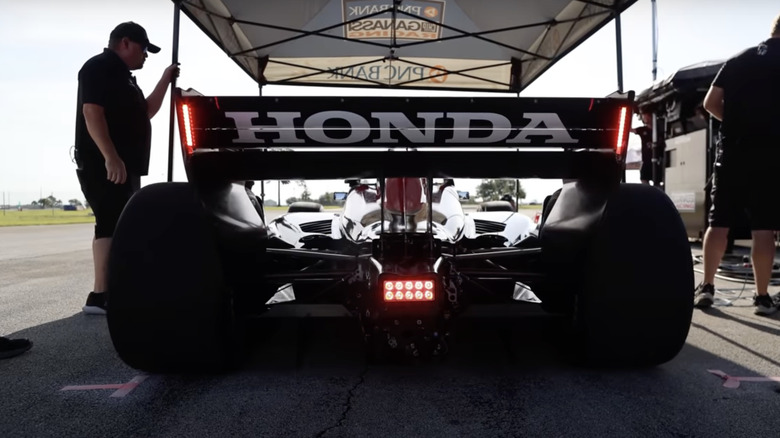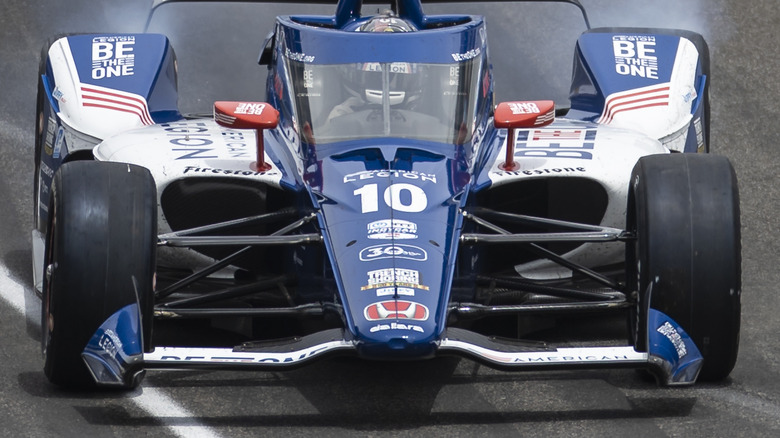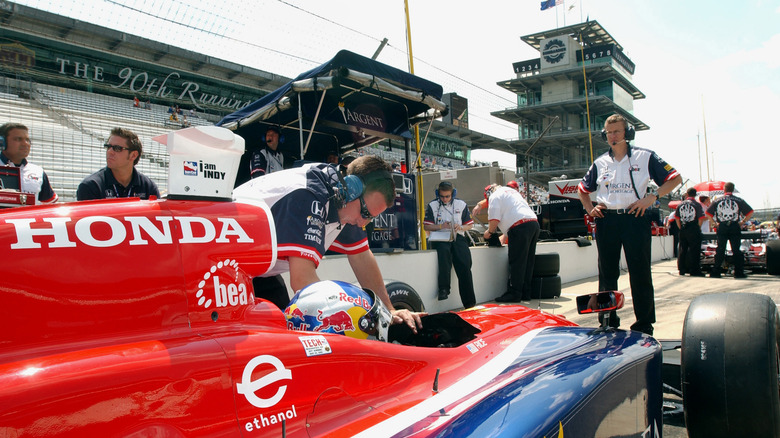Everything To Know About Honda's Indy V6 Engine
The Indy car racing series takes its name from its most notorious race, the Indianapolis 500. However, the series itself has a somewhat spotty history that includes an acrimonious late-1990s split into two rival championships; the CART series and the Indy Racing League. The two series unified in 2008, but by then, NASCAR had surpassed IndyCar as the more popular North American racing circuit.
IndyCar racing has made a resurgence in more recent years, with charismatic Spaniard Alex Palou taking two of the last three driver's championships, and Marcus Ericsson winning a dramatic Indy 500 in 2022. Ford, Chevrolet, and Toyota currently manufacture engines for use in NASCAR, but only Chevrolet and Honda build engines for the ten teams that will compete in IndyCar for 2024.
The 12 drivers that will race for Team Penske, Arrow McLaren, Ed Carpenter Racing, AJ Foyt Racing, and Juncos Hollinger Racing will use Chevrolet engines — while the 15 drivers that will run for Andretti Global, Meyer Shank, Rahal Letterman Lanigan, Dayle Coyne, and Chip Ganassi Racing will run under Honda power this year.
IndyCar's new hybrid engine has seen multiple delays
Honda has been supplying engines for Indy cars since 1994, but Honda and Chevrolet have both been working hard on the new 2.4-liter hybrid V6 powerplant that was initially proposed in 2019. When that announcement was made, the plan was to have the new engine in place for the 2022 season, but Ericsson's 2022 Indy 500 win was powered by the same twin-turbo 2.2-liter V6 that had been in use since 2012.
In December of that year, IndyCar announced the new engine's debut would be pushed back to the start of the 2024 season. However, last December 7, IndyCar announced in a press release that the new hybrid engine would make its first appearance "during the second half of the 2024 IndyCar Series season."
Testing took place last fall at the oval and road course at Indianapolis Motor Speedway and several other tracks, and continued into this year. COVID-related supply chain issues were initially to blame for the delays, but a report in the Indianapolis Star blamed Mahle, the maker of the new engine's hybrid power unit, for subsequent issues. Chevrolet and Honda scrambled to pick up the slack, but both manufacturers had their attention diverted to their efforts to produce more electric vehicles for non-racing customers, furthering delays.
The new Indy engine will produce as much as 900 horsepower
Despite the setbacks in getting the new engine to the track, IndyCar president Jay Frye had praise for the series' partners. "The partnership between Chevrolet and Honda has been phenomenal," he said last December. "The IndyCar-specific hybrid power unit is dynamic and an engineering marvel and we're completely committed to its successful introduction next season."
The core Motor Generator Unit (MGU) will be carried over from the old spec engine, while the Energy Recovery System and Energy Storage System (ERS and ESS) will be new. The hybrid components are expected to add about 100 horsepower to the engine, boosting total output to about 900 horsepower.
Last year, Honda's High Performance Development (HPD) team put some of the components it was building for its new IndyCar engine into a specially outfitted CR-V, and displayed it at six IndyCar races — including the season opener in St. Petersburg, Florida.
In a press release, HPD President and technical director David Salters boasted about his division's efforts. "This project vehicle is an IndyCar 'beast' in Honda CR-V 'sheep's clothing," he said. "The CR-V Hybrid Racer is our 'rolling electrified laboratory', to investigate where the talented men and women of HPD and Honda could go with electrification, hybrid technology and 100% renewable fuels."
Additionally, in an attempt to reduce the sport's carbon footprint, 2023 IndyCar vehicles switched from E85 fuel to a 100% ethanol-based fuel developed by Shell.


